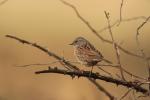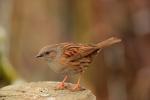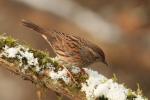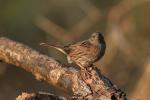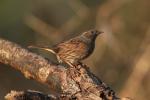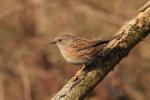Dunnock
Dunnocks are common little garden and hedgerow birds. Their markings, reveal their own beauty. They are grey on the head and chest, and brown elsewhere, with striated markings on the back. Sometimes these birds are known as hedge sparrows, although they are not actually related to sparrows; the body shape is very different, dunnocks having a sleeker body and thinner bill. Dunnock song is tuneless, but nonetheless a quite pleasant tinkling sound. They have a rather more colourful domestic arrangement than most birds, since females will often court other males whilst already mated with another. This ensures that her chicks will receive an adequate supply of food from both males, no matter who the father is. In the south of England, dunnocks are the preferred host for cuckoos. Even though cuckoo eggs look very different to their own, dunnocks unwittingly rear giant cuckoo chicks.
The Dunnock is resident throughout the UK except for the Shetland Isles. In winter the resident population is swelled by overwintering visitors from Europe.
In the late 1970s and early 1980s dunnock populations fell drastically, particularly in woodland habitats. This may be a result of changes to their habitat and food availability. However they are still widespread and common and populations appear to have stabilised since then. Signs of recovery have appeared in recent years and so the species is not considered to be under severe threat. At present the dunnock is on the amber list of species of conservation concern.
Dunnocks typically spend a lot of time on the ground, usually in well covered areas. The most likely place to see them in the garden is in hedgerows, where you may see them hopping around on the ground or between the branches. You may become more aware of them in spring as they prepare to mate. Dunnocks have been discovered to have far from dull mating habits, with possible combinations extending beyond the usual male-female pairing to include one female and two males, or two females and two males.
Primarily the Dunnock feeds on insects, helping to control populations that may otherwise cause damage to the garden environment. Occasionally they will also feed on seeds.
|

